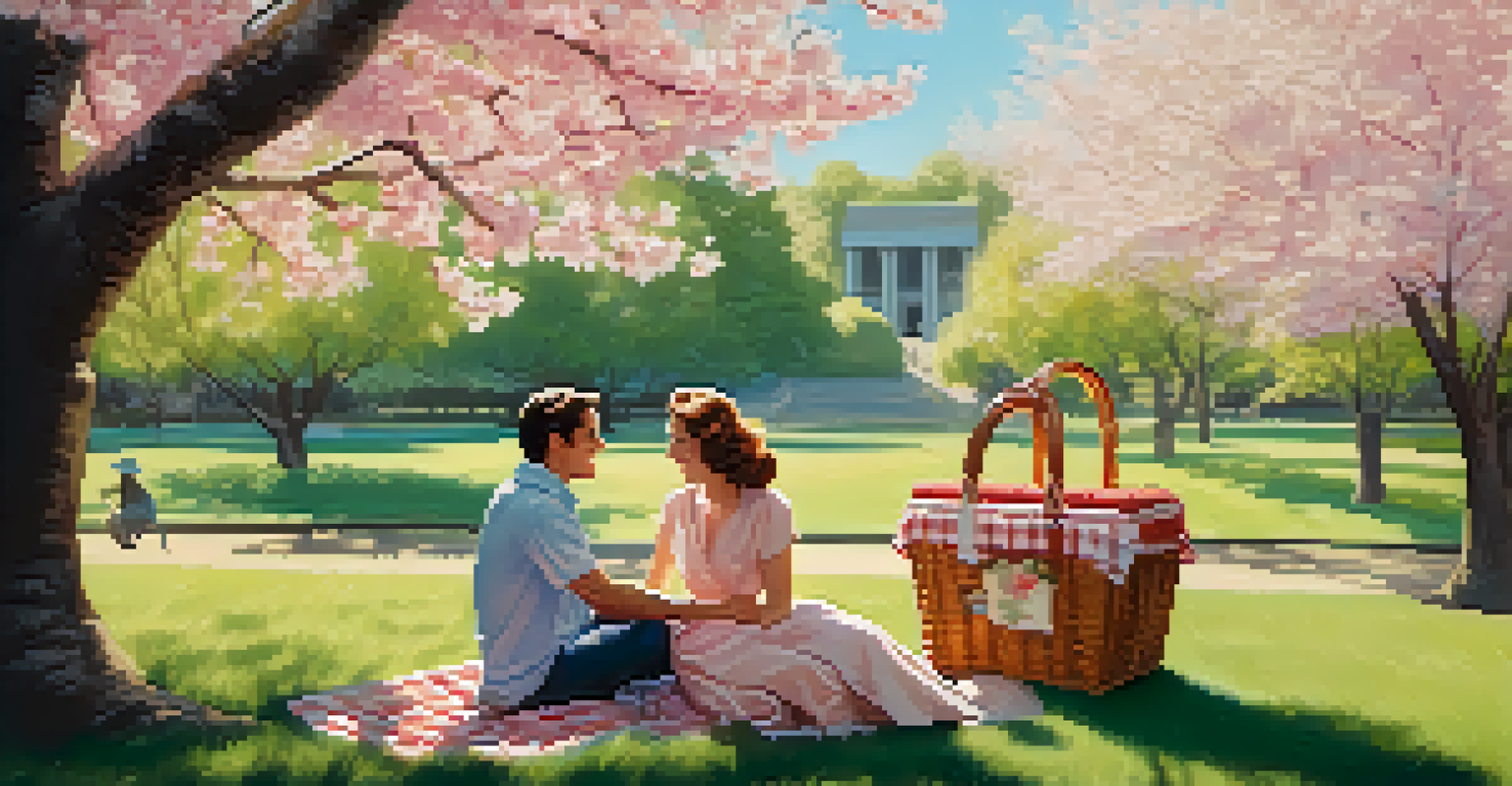The Impact of Film Posters on Audience Attraction

The Role of Visual Appeal in Film Posters
Film posters serve as the first impression of a movie, acting as visual teasers that can captivate an audience's attention. A well-designed poster uses striking imagery and colors to evoke emotions and intrigue viewers. For instance, the vibrant colors and iconic imagery of a superhero film can ignite excitement and anticipation, drawing in fans eager to see their favorite characters in action.
A picture is worth a thousand words.
Moreover, the use of typography in film posters plays a crucial role in conveying the film's genre and tone. A horror movie might use jagged fonts and dark colors to create a sense of dread, while a romantic comedy might opt for softer, playful designs. This strategic choice of visuals helps set expectations and attracts the right audience for the film.
Ultimately, the visual appeal of a film poster is about creating a connection with potential viewers. By crafting an eye-catching design that resonates with target demographics, filmmakers can significantly increase the chances of attracting a larger audience.
Understanding Target Audience Through Poster Design
Film posters are not just art; they are a strategic tool for understanding and appealing to specific audience segments. By analyzing demographics and psychographics, designers can tailor posters that resonate with the intended viewers. For instance, a poster for a family-oriented movie will likely feature bright colors and familiar characters that evoke warmth and joy.

In contrast, a thriller might emphasize darker themes and suspenseful imagery to attract a more mature audience. This targeted approach helps filmmakers ensure their marketing efforts reach those most likely to enjoy the film, increasing ticket sales and overall success.
Visual Appeal Captivates Audiences
Film posters serve as crucial visual teasers that evoke emotions and intrigue, significantly influencing audience interest.
Moreover, incorporating cultural elements into poster designs can enhance relatability for specific audiences. By reflecting the values and interests of a demographic, filmmakers create a sense of community and investment in the film, making audience attraction more effective.
The Psychological Impact of Color Choices in Posters
Color psychology plays a significant role in film poster design, influencing how audiences perceive a film even before they watch it. Certain colors evoke specific emotions; for example, red often symbolizes passion or danger, while blue can convey calmness or sadness. By carefully selecting color palettes, filmmakers can communicate underlying themes and emotions associated with their films.
Design is the silent ambassador of your brand.
For instance, consider how a romantic drama might use soft pinks and whites to evoke feelings of love and tenderness, while an action film might incorporate bold reds and blacks to suggest intensity and excitement. The right color can resonate deeply with potential viewers and create an emotional connection long before the film begins.
Understanding the psychological impact of color allows filmmakers to craft posters that not only attract attention but also convey the film's essence. This strategic use of color can significantly influence audience attraction and engagement.
Iconic Imagery: The Power of Symbolism in Film Posters
Symbolism in film posters can create powerful connections with audiences, often eliciting curiosity and interest. Icons, whether they are characters, objects, or specific scenes, can convey the essence of a film in a single glance. For instance, the iconic lightsaber from Star Wars immediately signifies an epic space adventure, appealing to fans of the genre.
Moreover, utilizing well-known symbols can also tap into existing fanbases and nostalgia, making a film more appealing to those who have fond memories of similar works. This is particularly effective in franchises where elements like logos and character designs become instantly recognizable.
Target Audience Shapes Design Choices
Understanding demographics allows filmmakers to create tailored posters that resonate with specific audience segments.
Through clever use of symbolism, filmmakers can create posters that resonate on a deeper level, inviting audiences to explore the story behind the imagery. This connection can be the key to drawing in viewers who might otherwise overlook the film.
The Importance of Typography in Film Poster Design
Typography is often an overlooked aspect of film poster design, yet it plays a crucial role in conveying the film's tone and genre. The choice of fonts can reflect the film's personality, creating immediate associations in the viewer's mind. For example, a horror film may use bold, distressed fonts to evoke a sense of fear, while a romantic comedy might opt for whimsical, rounded letters to suggest lightheartedness.
Additionally, the placement and size of text can impact how information is perceived. A large title grabs attention, while smaller credits at the bottom provide essential details without overwhelming the design. This balance is vital for creating an engaging poster that informs and attracts.
By mastering the art of typography, filmmakers can enhance their posters' effectiveness, ensuring they communicate the right messages to potential audiences. The right font choice can make all the difference in how a film is perceived before it even hits the screen.
Historical Evolution of Film Posters and Audience Attraction
The evolution of film posters reflects broader changes in society, technology, and audience preferences. In earlier decades, posters were often hand-painted, emphasizing artistic expression over marketing strategies. However, as film became a major entertainment medium, the focus shifted toward creating eye-catching designs that effectively communicated a film's appeal to attract audiences.
With the advent of digital technology, filmmakers gained new tools to create stunning visuals and experiment with designs. Today, posters often incorporate intricate graphics, layered images, and dynamic compositions, all aimed at grabbing the viewer's attention in a crowded marketplace. This evolution highlights the importance of staying current with design trends to effectively attract audiences.
Color Psychology Enhances Engagement
Strategic color choices in film posters can evoke specific emotions, shaping perceptions and attracting potential viewers.
By understanding the historical context of film posters, filmmakers can appreciate the ongoing transformation of audience attraction strategies. Each generation brings fresh perspectives on what draws viewers in, making it essential to adapt and innovate in poster design.
The Impact of Social Media on Film Poster Promotion
In today's digital age, social media plays a pivotal role in how film posters are disseminated and promoted. Platforms like Instagram and Twitter allow filmmakers to share their posters widely, reaching audiences directly and encouraging engagement. This immediate access can amplify interest and anticipation for upcoming films, especially among younger demographics who are more likely to engage with visual content online.
Moreover, social media offers a unique opportunity for audience interaction through likes, shares, and comments. A well-crafted poster can generate buzz and discussions, making it a vital tool for building hype before a film's release. This interactive approach can create a sense of community around the film, enhancing audience attraction.

As filmmakers embrace the power of social media, they can leverage film posters not just as marketing tools but as conversation starters. Engaging with audiences online can foster a deeper connection, leading to increased interest and attendance when the film finally hits theaters.